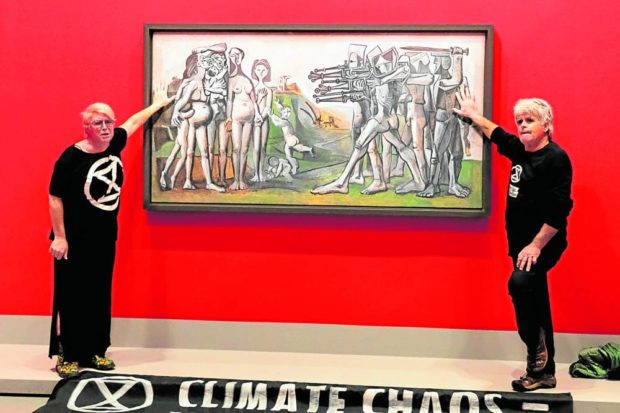
NEW CONTEXT FOR PICASSO | This photo from the environmental movement Extinction Rebellion shows climate activists with their hands glued to the perspex covering Pablo Picasso’s 1951 antiwar masterpiece “Massacre in Korea” at the National Gallery of Victoria in Melbourne. (Photo from Extinction Rebellion via Agence France-Presse)
SYDNEY — Two climate activists glued their hands to the perspex covering of Picasso’s antiwar painting “Massacre in Korea” in a Melbourne art gallery on Sunday, according to police, protesters, and the gallery.
The painting emerged unscathed.
The black-clad activists were shown with their hands pressed against the Picasso in a room of the National Gallery of Victoria in images shared on social media by the Extinction Rebellion movement.
A man wearing a T-shirt with the Extinction Rebellion symbol — an hourglass in a circle — stood alongside them. On the ground at their feet lay a black banner reading “Climate Chaos = War + Famine.”
“It is believed three protesters entered the ground level of the gallery before a man and a woman glued themselves to a protective covering of a Picasso painting,” said a Victoria Police spokesperson.
The protesters—a 49-year-old woman from New South Wales and a 59-year-old man from Melbourne—were “removed from the painting” more than an hour after their action was believed to have started, police said.
‘Horrors of war’
The pair, alongside a 49-year-old Melbourne man, “have been arrested and are assisting police with their inquiries,” they said.
The gallery said it had called the police and closed the exhibition to the public.
“The protesters’ hands were safely removed from the perspex with no harm to the work,” said a spokesperson for the National Gallery of Victoria.
The 1951 Picasso work “shows the horrors of war,” Extinction Rebellion Victoria said on its Facebook page.
The painting was, in turn, inspired by another masterpiece from the 19th century, Francisco Goya’s “The Third of May, 1808.”
“Climate breakdown will mean an increase in conflict around the world. Now is the time for everyone and all institutions to stand up for action!” the group said.
The painting was being shown on the final day of the gallery’s “The Picasso Century” exhibition.
RELATED STORIES
Climate activists disrupt traffic in London, Paris
Big nations urged to heed climate activists’ demands for bolder action
Police clear climate activists from heart of Zurich financial district